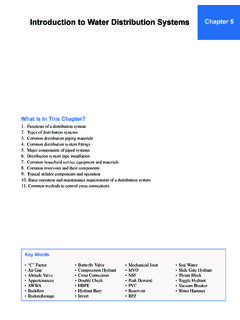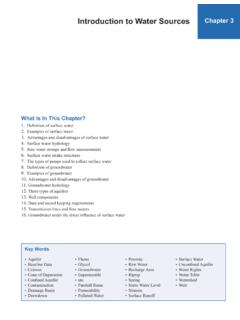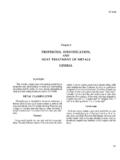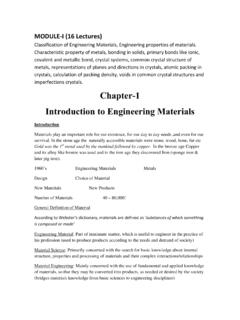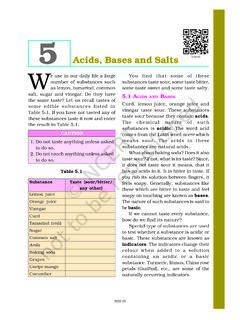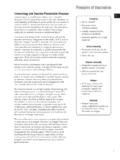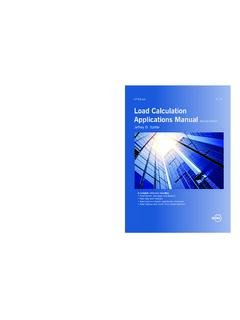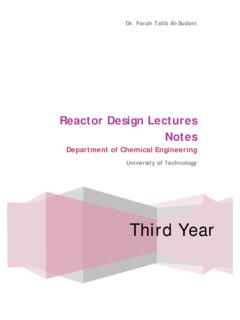Transcription of Basic Electricity and Motor Controls Chapter 7
1 Chapter 7 What Is In This Chapter ?1. The Basic components of an atom 2. Basic electrical units and symbols 3. The difference between a conductor and an insulator 4. The difference between open and closed circuits5. The difference between AC and DC power 6. All explanation of single and three phase power 7. How electromagnets work 8. The function of common electrical components found in small water systems9. Common pump electrical control componentsBasic Electricity and Motor ControlsKey Words AC Amperage Atom Brake Horsepower Conductor DC Electromagnetism Electron EMF Heater Hertz Horsepower Insulator Magnetic Breaker Magnetic Starter Neutron Proton Resistance Sine Wave Single Phase Power Three Phase Power Voltage224 Basic Electricity and Motor ControlsChapter 7In order to develop a Basic understanding of how electrical equipment and Motor Controls work, we need to review Basic electrical theory.
2 And since electrical theory is based on atomic theory, we need to begin with a review of how atoms TheoryThe Atom NucleusIf we break matter into its smallest component, the base unit is the atom1. An atom is composed of three components: the center is called the nucleus and contains two types of particles, protons and neutrons. The protons have a positive charge and the neutrons2 have a neutral or zero ElectronOrbiting around the nucleus are one or more electrons. The electron3 is extremely small. It travels at nearly the speed of light and has an electrical charge that is nega-tive.
3 This charge is equal in value to the positive charge of the of the AtomThe electrons remain a constant distance from the nucleus of the atom. There are two forces that hold them in this position. One is the electrical attrac-tion between the negative electrons and the elec-tron positive protons. This has the tendency to pull the electrons into the nucleus. The second force is centrifugal force. Centrifugal force tries to make the electrons fly away from the nucleus. The two forces counteract each other and hold the electrons stable in their ShellsThe electrons in an atom form shells (or orbits) around the nucleus.
4 Each shell has a precise number of electrons. Each element has a different number of electrons. The atoms of the heavier elements have multiple shells. Regardless of the element, atoms are most stable when they have eight electrons in their outermost than EightWhen an atom has five or more, but fewer than eight, electrons in its outer shell, the atom prefers to gather more electrons to be satisfied. This type of material is called an acceptor. Electrically, materials that are acceptors are called insulators5. They do not allow the flow of electrons easily. Examples of insulators include glass, plastic, and than FiveWhen an atom contains fewer than five electrons in its outer shell, it is easier for it to give up the excess than to gain more electrons.
5 Atoms with fewer than five electrons are called donors. Electrically, materials that have fewer than five electrons are called conductors6. These atoms allow electrical current to flow easily. Examples of con-ductors include copper, gold, aluminum, and Basics1 Atom The smallest part of an ele-ment that still retains the properties of that Neutron A neutrally charged particle in the nucleus of an atom. This particle has the same weight as a proton, an atomic weight of Electron A negatively charged par-ticle that travels around the nucleus of an Proton A positively charged particle in the nucleus of an atom.
6 This particle has an atomic weight of 1 and an atomic charge of plus Insulator A substance, body, or device that prevents the flow of elec-trical Conductor A substance, body, device, or wire that readily conducts or carries electrical 7 Basic Electricity and Motor Controls7 EMF (Electromotive Force) The electrical pressure (voltage) that forces an electric current through a Resistance The opposition offered to the flow of electrical current. Usu-ally measured as Electrons MoveIn order to cause the electrons of a donor material to leave the atom, sufficient energy must be applied to cause the electron to speed up enough to overcome the attraction of the proton.
7 Energy can be applied mechanically by a generator, by light, by pres-sure, by chemical reactions, and by simplest way to look at electrical energy is with a battery. A dry cell battery is made from a chemical paste and two electrodes. The chemical reaction between the chemical paste and the electrodes causes an excess of electrons to accumulate on one post, which creates an electrical charge difference between the two posts. If a conductor is connected between the two posts, electrons will flow from one post to of Electricity PressureThe battery can be viewed as an electrical pump. There is an electrical force differ-ence between the two poles.
8 This electrical difference is called electromotive force or EMF7 for short. If the battery were visualized as a water pump, this difference would be the difference in pressure between the suction and discharge of the pump. Pressure VoltsElectrical pressure is called voltage8. The units of measurement are volts. The symbol for volts can be E (for EMF) or V (for volts). Voltage is measured with a volt meter. A common volt meter used by operators is a VOM (Volt, Ohm, Milliamp Me-ter).FlowThe flow of electrons from one point to another is called current. Current is measured as amperage (amps for short).
9 Current or amps is similar to flow in gallons per minute in a water line. The electrical symbol for amps is I or A. Amperage is measured using an amp meter. ResistanceThe resistance9 to the flow of electrons is called resistance. This is similar to head-loss in a water line. Resistance is measured as ohms. Electrically, the symbol for resistance is (the Greek letter omega) or R. +-CHEMICAL PASTEZINCCASECARBONROD8 Voltage The measurement of EMF between two Electricity and Motor ControlsChapter 7 Electrical Measure-mentUnitsSymbolsWater EquivalentWater UnitsPressure (EMF)VoltsE or VPressurepsiCurrentAmpsI or AFlowgpmResistanceOhms or RHeadlossfeetReview1.
10 The item that rotates around the nucleus of an atom is the The _____ and the _____ can be found in the nucleus of an Examples of good electrical conductors include:4. _____ is the electrical unit that is related to pressure; _____ is the electrical unit that is related to flow; and _____ is the electrical unit that is related to The symbol for voltage is _____ or _____; the symbol for amperage is _____ or _____; and the symbol for resistance is _____ or EMF stands for _____ force and is the same as of CircuitsThere are two types of electrical circuits that we need to be concerned with: Open Circuit An open circuit is similar to having the light switch in the off position.

